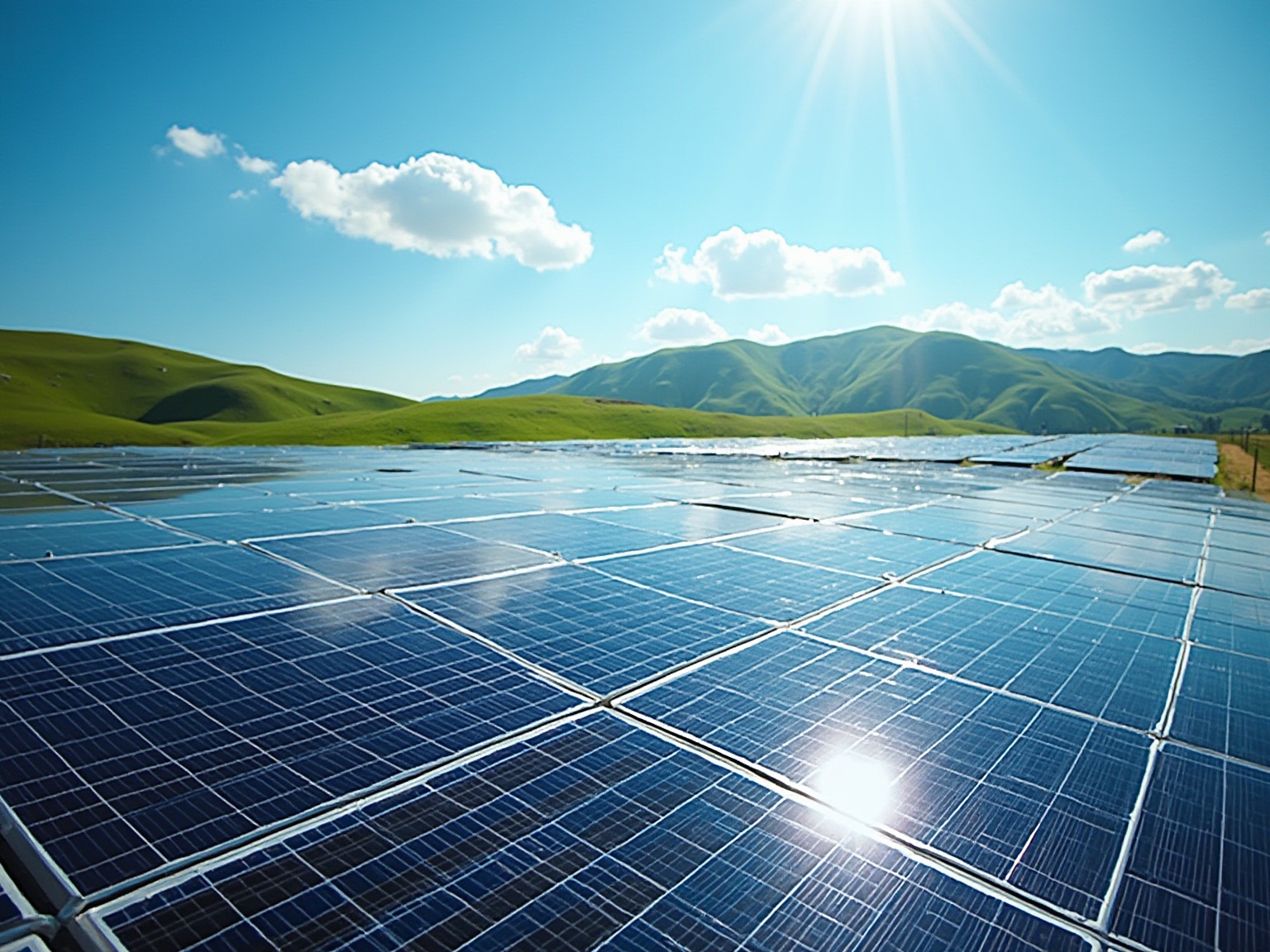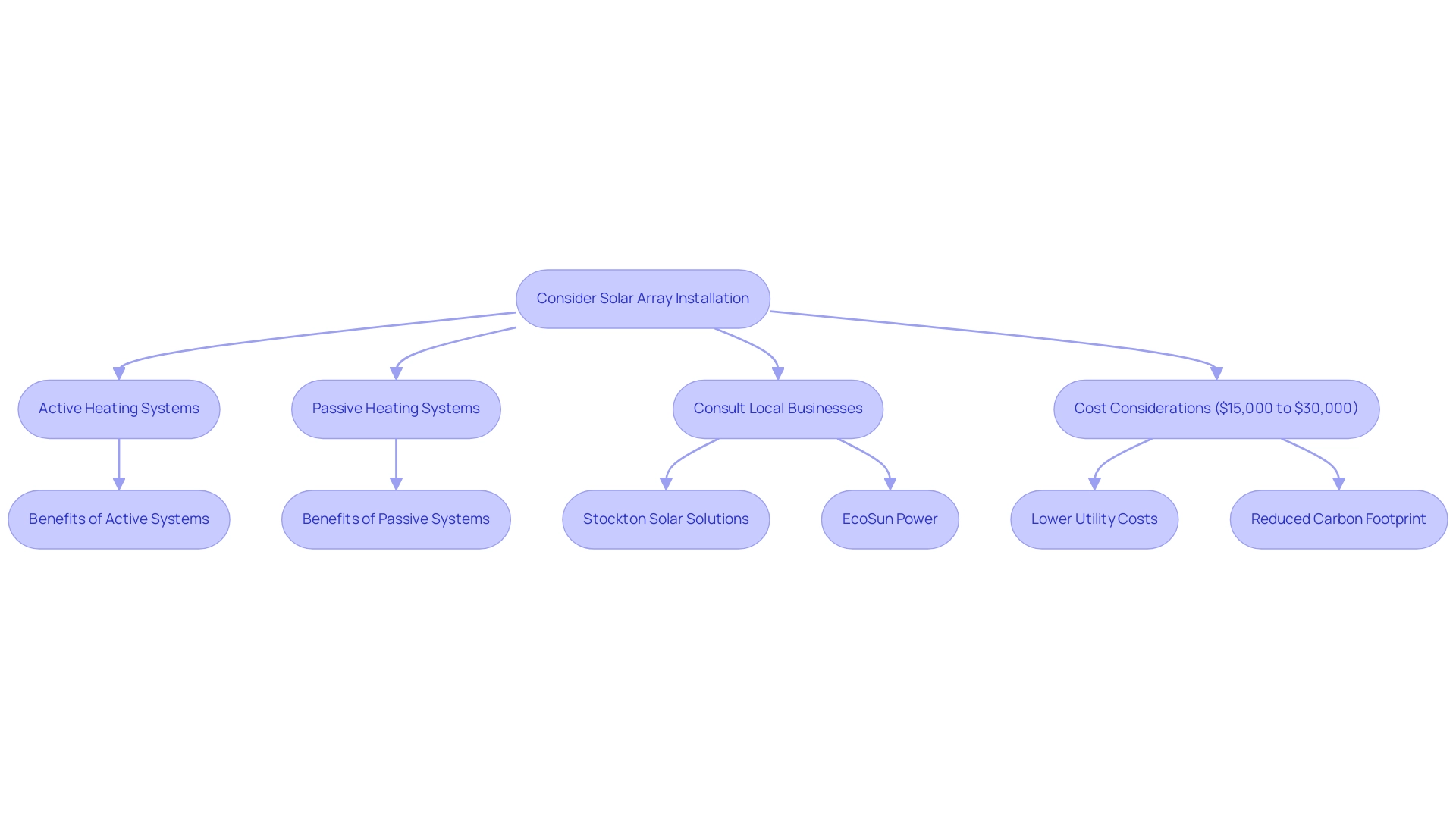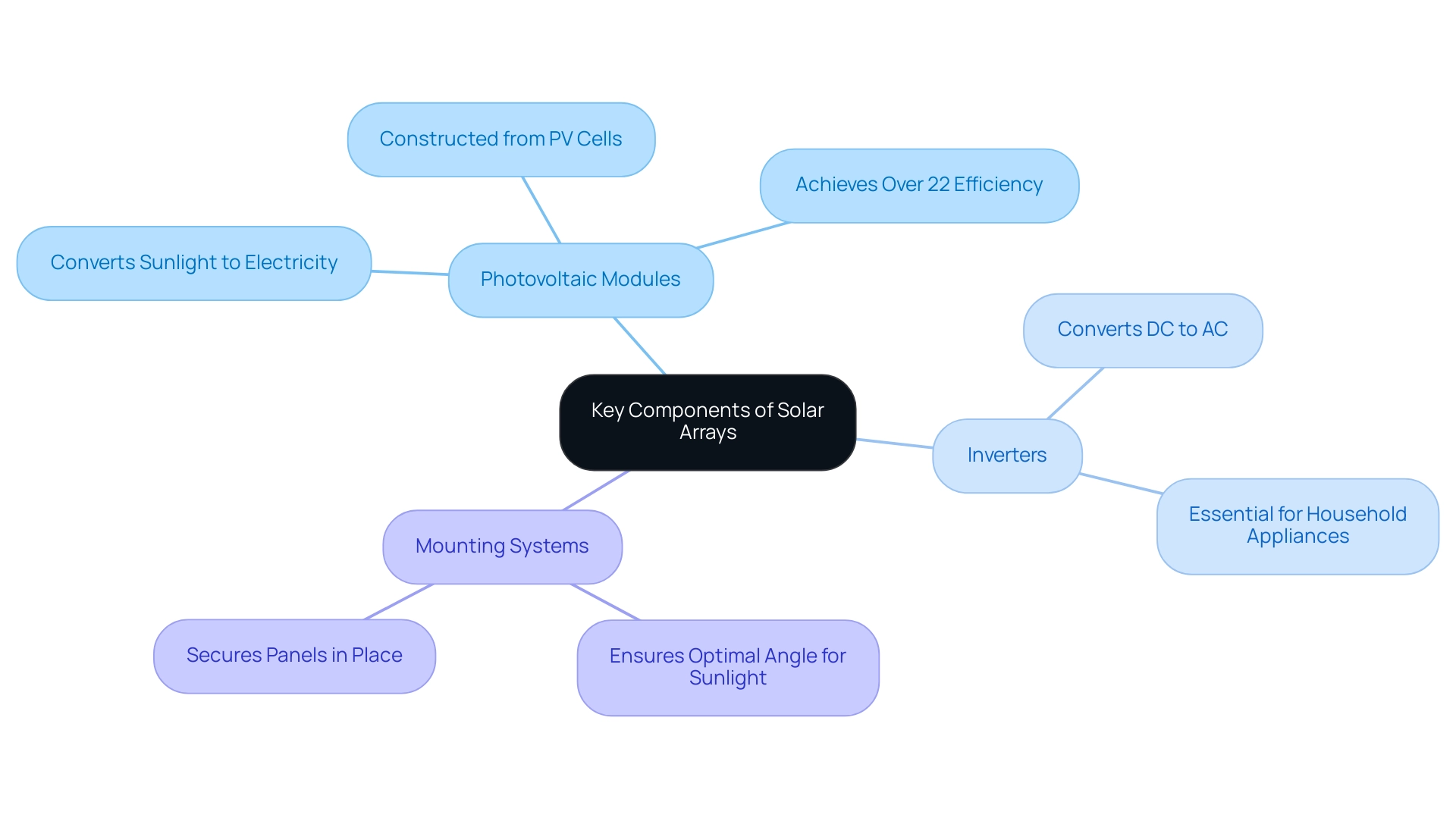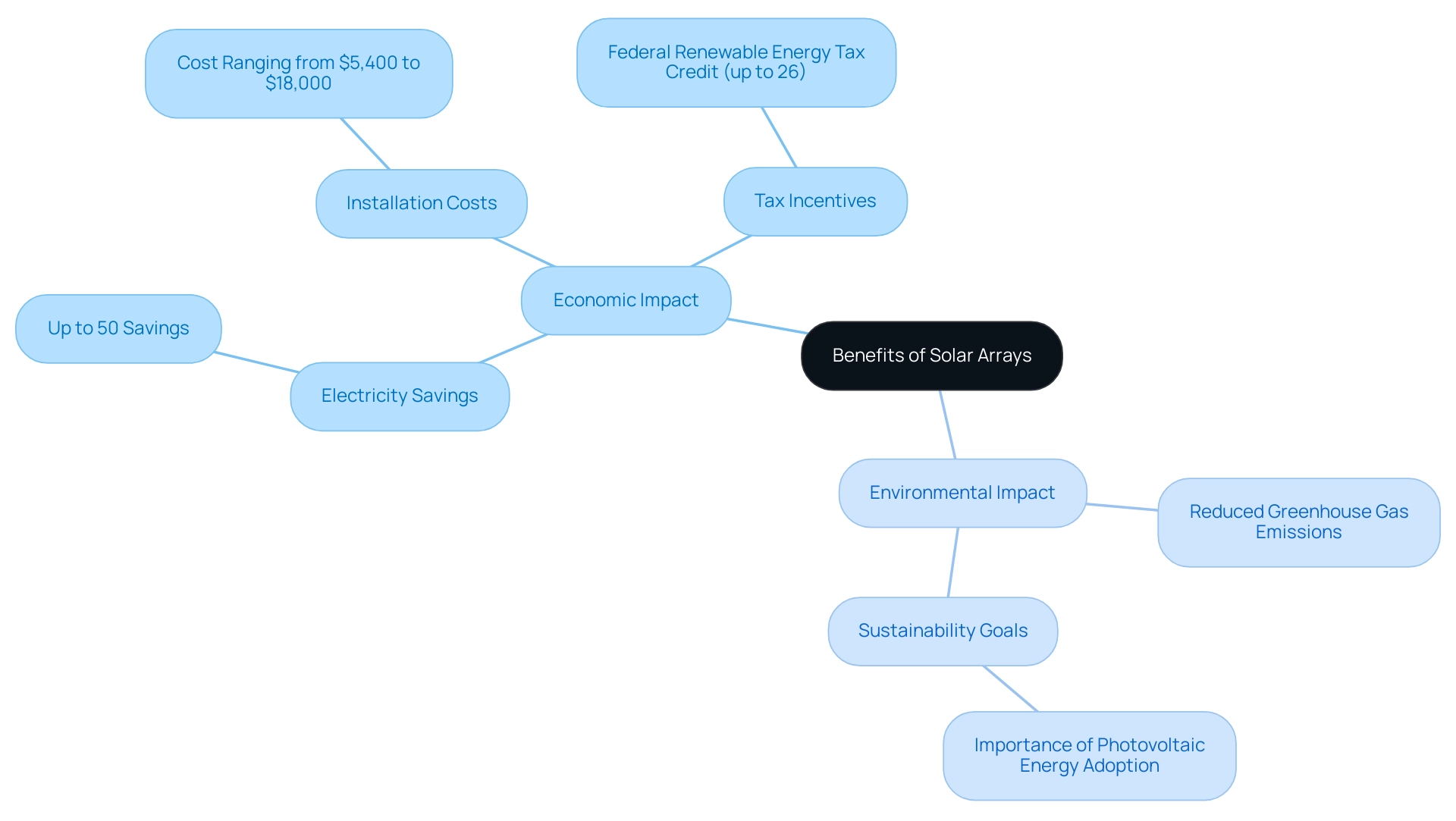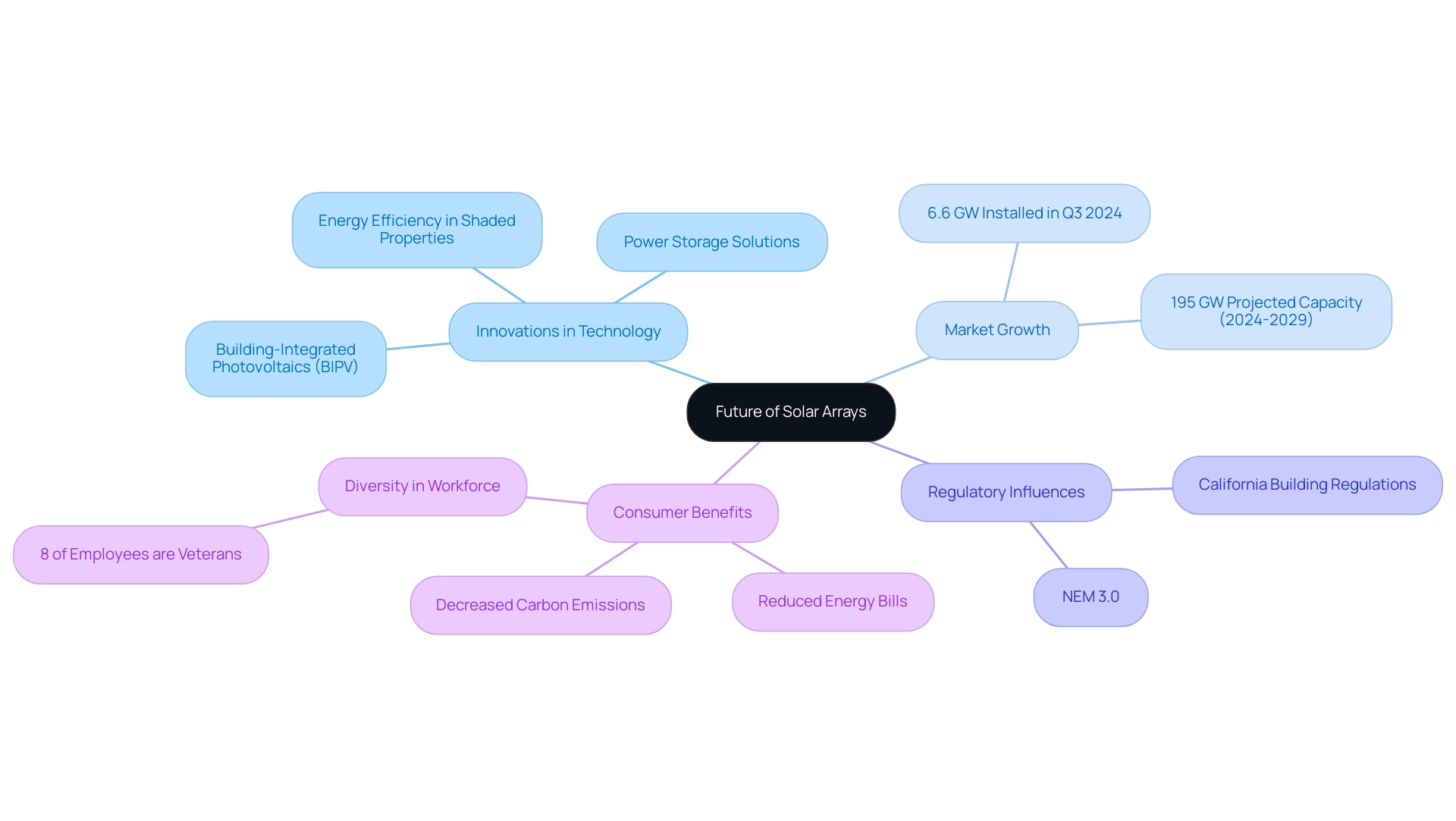Overview
Solar arrays are collections of solar panels designed to capture sunlight and convert it into usable electricity, playing a crucial role in the transition to renewable energy. The article emphasizes their importance by detailing the economic benefits, such as reduced utility costs and tax incentives, as well as environmental advantages, including decreased greenhouse gas emissions, making them a viable investment for eco-conscious homeowners.
Introduction
As the world increasingly turns its gaze towards sustainable energy solutions, solar arrays have emerged as a beacon of hope for eco-conscious homeowners.
These systems, composed of multiple solar panels working in harmony, not only harness the sun’s energy but also promise significant economic and environmental benefits. In regions like Stockton, California, the drive towards solar energy is fueled by advancements in technology and a growing awareness of the need for energy independence.
With the potential to drastically reduce electricity bills and lower carbon footprints, understanding the nuances of solar arrays—from their design and installation to the latest innovations—becomes essential for those looking to invest in a greener future.
As the solar market evolves, homeowners are presented with a plethora of choices, each tailored to meet unique energy demands and sustainability goals.
Defining Solar Arrays: An Overview
A collection of panels works together to capture sunlight and transform it into usable electricity. Typically located on rooftops or as ground-mounted setups, these arrays are designed to optimize sunlight capture efficiently. Homeowners in Stockton, California, should consider both active and passive heating systems when installing panels, as these methods can significantly influence the performance and efficiency of their arrays.
Local businesses like Stockton Solar Solutions and EcoSun Power provide a variety of products designed to satisfy different power requirements. The dimensions and arrangement of a power array can differ greatly, customized to satisfy the particular requirements of a household while taking into account available space and local weather conditions. With the recent increase in U.S. module imports to nearly 15.4 GW and advancements in photovoltaic technologies resulting in falling prices, renewable sources are becoming more appealing for eco-conscious homeowners.
Costs for photovoltaic panel installations in Stockton usually vary from $15,000 to $30,000, based on size and particular product characteristics. It’s crucial to acknowledge that photovoltaic systems not only produce electricity but also lower utility costs and decrease carbon footprints. Comprehending the dynamics of solar arrays meaning is essential for property owners seeking to invest in sustainable power alternatives, particularly as they explore the advantages of cost savings, ecological effects, and the long-term worth of heating units.
Despite recent market challenges, including a noted 4% decline in residential solar installations in Q3 2024 due to high electricity bills and changing net metering rules, the outlook for solar power remains optimistic. By carefully considering the installation process and the advantages of both active and passive options, homeowners can make informed decisions that align with their energy needs and sustainability goals.
Types of Solar Arrays: From Fixed to Tracking Systems
Solar arrays meaning can be fundamentally categorized into two primary types: fixed and tracking configurations. Fixed arrays are designed to remain stationary at a predetermined angle, allowing them to capture sunlight efficiently throughout the day. In contrast, tracking mechanisms employ motors to modify the panels’ alignment in real time, following the sun’s path to optimize power generation.
This dynamic capability significantly enhances the efficiency of sunlight capture, making it essential for eco-conscious homeowners to grasp the solar arrays meaning and the advantages of each setup. Although fixed setups are common because of their reduced installation and upkeep expenses, tracking setups frequently generate greater power outputs, which can be especially advantageous for larger installations where both space and budget are accessible. In areas like Manta, with an annual sunlight radiation average of 4.88 kWh/m², the energy yield from tracking systems becomes particularly compelling.
Furthermore, the performance of photovoltaic cells can be influenced by temperature, as evaluated by the LM35 temperature sensor, highlighting the importance of regular maintenance to ensure efficiency and longevity. Industry experts emphasize the value of training and resources for optimizing energy technologies, such as the new training bundle offered by PVcase and HeatSpring for utility-scale engineering. Additionally, case studies like ‘Horizontal Perspective of Positioning’ underline the significance of calculating the direct beam irradiation angle, crucial for optimizing collector orientation.
When assessing energy alternatives, it’s crucial to consider the benefits of tracking setups, especially regarding energy efficiency and long-term returns on investment, while also acknowledging the practicality and cost-effectiveness of fixed installations, as this relates to solar arrays meaning. To further assist property owners, user manuals outlining panel functionality and maintenance best practices are invaluable resources. Furthermore, choosing the appropriate battery is essential; batteries such as the Tesla Powerwall and LG Chem RESU provide outstanding financial advantages and compatibility with both fixed and tracking setups.
This comprehensive understanding can result in informed choices regarding battery selections and overall renewable power solutions, ultimately aiding in independence and sustainability for homeowners.
Key Components of Solar Arrays: Understanding the Technology
The essential elements of photovoltaic arrays include photovoltaic modules, inverters, and mounting systems, each serving a vital function in capturing sunlight effectively. Solar panels, primarily constructed from photovoltaic (PV) cells, are designed to convert sunlight into electricity, serving as the primary energy source for residential applications and significantly reducing utility costs. Inverters are equally essential, converting the direct current (DC) produced by the panels into alternating current (AC), the standard form of electricity utilized by most household appliances.
The mounting system securely positions the panels, ensuring they are optimally angled to maximize sunlight exposure throughout the day.
Understanding these components is essential for eco-conscious homeowners who wish to appreciate the solar arrays meaning and how photovoltaic arrays operate, along with the technology driving their efficiency. As of October 28, 2024, there has been a significant influx of photovoltaic technology, with over 9.4 GW of cells imported, reflecting the growing market for renewable energy solutions and the ongoing push for economic and environmental benefits through initiatives like the Biden-Harris administration’s Solar for All program. Recent advancements in panel technology have led to improved efficiency rates, with the latest models achieving over 22% efficiency, showcasing the continued research and development in this field.
Moreover, the industry has emerged as a viable employment sector, with 8% of employees being veterans, highlighting its capacity to create meaningful job opportunities while contributing to greenhouse gas reduction. Cristen Hemingway Jaynes observed that the 2°C climate warming goal is ‘dead,’ highlighting the urgent necessity for innovative solutions such as renewable energy technology to address climate change. With solar power expected to produce a quarter of the world’s electricity by 2030, grasping these essential elements will enable property owners to make informed choices about their solar investments, improving autonomy and encouraging sustainability.
The Benefits of Solar Arrays: Economic and Environmental Impact
Solar arrays meaning a wealth of economic and environmental advantages for eco-conscious homeowners. Economically, these systems can dramatically reduce electricity expenses, yielding long-term savings, particularly in states like California where utility costs are notably high. Homeowners can anticipate average savings from renewable energy to attain remarkable levels, with some reporting decreases in their electricity bills by up to 50%.
The cost of PV installation ranges from $5,400 to $18,000, a crucial consideration for potential adopters. However, federal and state tax incentives, such as the federal renewable energy tax credit, can enable many homeowners to decrease their initial investment by up to 26%. Powercore Electric, a locally-owned business, understands the unique electrical requirements of California communities, ensuring customized solutions that maximize these benefits.
As one pleased client mentioned, ‘Powercore changed our utility expenses; we’re saving significantly each month due to their expert installation.’ According to the Solar Power Industries Association (SEIA), roughly 4.7 million photovoltaic systems, known as solar arrays meaning, were operational in the United States as of Q3 2023, highlighting their increasing adoption. On the environmental front, the solar arrays meaning refers to photovoltaic systems that play a crucial role in decreasing greenhouse gas emissions by harnessing clean, renewable power.
This transition not only assists in the battle against climate change but also improves independence and sustainability in communities. As Matt Bessey, CTO of Payaca, emphasizes in his discussions on accelerating net zero, the adoption of photovoltaic energy is vital for achieving sustainability goals. Moreover, ongoing discussions highlight the pressing need for efficient energy solutions, as evidenced by case studies like the Solar Roads project, which faced significant challenges, yet underscored the importance of innovative approaches in the energy sector.
Installing Solar Arrays: What Homeowners Need to Know
Installing photovoltaic arrays is a multifaceted process that begins with a thorough property assessment, aimed at identifying the optimal system size and configuration. Homeowners must evaluate their roof’s orientation, shading, and local regulations, which can significantly influence installation success. In 2024, the average cost of photovoltaic array installation reflects various factors, including the potential 30% federal tax credit, significantly reducing upfront expenses.
This incentive, along with government photovoltaic panel initiatives, can improve accessibility for environmentally aware residents seeking to invest in renewable energy. To navigate government solar panel programs, individuals should start by researching available local incentives and rebates, which can vary by region. The Department of Energy states that the Solar App+ aims to streamline the interconnection process, making it cheaper and quicker for everyone, underscoring the importance of efficiently navigating local regulations.
After selecting a qualified installer, the next steps typically involve:
- Securing necessary permits
- Mounting the panels
- Connecting the system to the electrical grid
It is crucial for homeowners to choose reputable contractors, as their expertise can greatly impact the project’s outcome. Additionally, inquiring about warranties and annual maintenance—typically costing around $150—ensures the array’s longevity and efficiency.
Regular maintenance is essential not only for efficiency but also for preserving the economic and environmental advantages that renewable energy offers. Notably, the depletion of the California queue and higher financing costs have negatively impacted residential installations, leading to the lowest quarter for new setups since 2021. Furthermore, in Q3 2024, U.S. module imports increased to almost 15.4 GW, illustrating broader market dynamics that influence panel availability and costs.
Understanding the solar arrays meaning and how photovoltaic panels transform sunlight into energy is crucial for property owners. This knowledge can lead to more informed decisions, ultimately making renewable energy more accessible to homeowners, especially in eco-conscious communities like Long Beach.
The Future of Solar Arrays: Innovations and Trends in Renewable Energy
The future of solar arrays meaning is set to undergo remarkable transformations, powered by continuous research and technological breakthroughs. A prominent trend within this evolution is the rise of building-integrated photovoltaics (BIPV), which seamlessly incorporate energy-converting cells into building materials, enhancing both functionality and aesthetics. With California’s building regulations and NEM 3.0 facilitating greater renewable power adoption, residents in Northern California stand to gain considerably from these developments.
Advancements in power storage solutions are also gaining momentum, further enhancing the solar arrays meaning and their efficiency. As the urgency for renewable energy solutions escalates, particularly in light of alarming climate change indicators such as the North Pole temperature reaching 20°C above average, the photovoltaic industry is on track to deliver increasingly efficient, cost-effective, and versatile options for eco-conscious homeowners. Notably, 8% of employees in the renewable energy sector are veterans, compared to 5% of the overall U.S. workforce, highlighting the diversity within this growing industry.
Recent growth trends indicate that the utility-scale renewable energy sector has reached unprecedented heights, with a record 6.6 GW installed in the third quarter of 2024 alone, marking a 44% year-over-year increase. This momentum reflects a robust project pipeline poised to bring an estimated 195 GW of new utility-scale energy capacity online between 2024 and 2029. Moreover, the U.S. Energy Information Administration forecasts that benchmark Brent crude oil prices will decrease from an average of $81 per barrel in 2024 to $74 per barrel in 2025, further underscoring the economic factors influencing the renewable power market.
Such advancements not only align with consumer demands but also highlight solar arrays meaning as a cornerstone of future energy solutions, offering economic benefits such as reduced energy bills and environmental benefits like decreased carbon emissions. Furthermore, tackling challenges in shaded properties remains essential, with innovative solutions being developed to enhance energy efficiency even in less-than-ideal conditions. Government programs aimed at promoting solar adoption and cleaning services for maintaining solar panels are also vital components of the solar landscape, ensuring that homeowners can maximize their investments and contribute to a sustainable future.
Conclusion
Solar arrays represent a pivotal advancement in sustainable energy solutions, offering homeowners in regions like Stockton, California, a practical pathway to reducing electricity costs and minimizing environmental impacts. By understanding the components, types, and installation processes of solar arrays, homeowners can make informed decisions that align with their energy needs and sustainability goals.
The dual benefits of economic savings and environmental responsibility underscore the importance of solar energy adoption. With the potential for significant reductions in electricity bills and the support of federal and state incentives, investing in solar technology becomes not only an eco-friendly choice but a financially sound one as well. As the market evolves with new innovations and trends, such as building-integrated photovoltaics and enhanced energy storage solutions, the future of solar arrays looks promising.
Ultimately, as the urgency for renewable energy solutions grows, embracing solar technology is essential for achieving energy independence and contributing to a sustainable future. Homeowners are encouraged to explore the vast opportunities within the solar landscape, ensuring they are well-equipped to harness the sun’s power for both their households and the planet.


